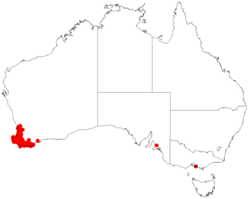Biology:Leucopogon verticillatus
| Tassel flower | |
|---|---|

| |
| Leucopogon verticillatus in Beelu National Park | |
| Scientific classification | |
| Kingdom: | Plantae |
| Clade: | Tracheophytes |
| Clade: | Angiosperms |
| Clade: | Eudicots |
| Clade: | Asterids |
| Order: | Ericales |
| Family: | Ericaceae |
| Genus: | Leucopogon |
| Species: | L. verticillatus
|
| Binomial name | |
| Leucopogon verticillatus R.Br.[1]
| |

| |
| Occurrence data from AVH | |
Leucopogon verticillatus, commonly known as tassel flower,[2] is a species of flowering plant in the heath family Ericaceae and is endemic to the southwest of Western Australia. It is an erect, bamboo-like shrub with broadly lance-shaped leaves and pink, tube-shaped flowers crowded along spikes in leaf axils and on the ends of branches.
Description
Leucopogon verticillatus is an erect, glabrous shrub that typically grows up to 1.5 m (4 ft 11 in) high. The leaves are light green, broadly lance-shaped, mostly 50–100 mm (2.0–3.9 in) long, 25 mm (0.98 in) wide and sharply pointed. The leaves are mostly crowded at the ends of each year's growth, so that they appear whorled. The edges of the leaves are turned down and there are fine veins visible on the surface. The flowers are crowded along unbranched spikes up to 60 mm (2.4 in) long in leaf axils and on the ends of branches. The bracts and bracteoles are less than half the length of the sepals. The sepals are about 2 mm (0.079 in) long, and the petals are pink, about 4 mm (0.16 in) long and joined at the base forming a tube with lobes about half the length of the petal tube. Flowering occurs in September and October.[2][3][4]
Taxonomy
Leucopogon verticillatus was first formally described in 1810 by Robert Brown in his Prodromus Florae Novae Hollandiae et Insulae Van Diemen.[5][6] The specific epithet (verticillatus) means "verticillate", referring to the leaves.[7]
Distribution and habitat
This leucopogon often grows in lateritic or gravelly soils in wet places in karri, jarrah, and marri forest between Perth and Waychinicup National Park in the Esperance Plains, Jarrah Forest, Swan Coastal Plain and Warren bioregions of southern Western Australia.[2][8]
Conservation status
Leucopogon verticillatus is listed as "not threatened" by the Government of Western Australia Department of Biodiversity, Conservation and Attractions.[2]
References
- ↑ "Leucopogon verticillatus". https://biodiversity.org.au/nsl/services/apc-format/display/68512. Retrieved 15 June 2023.
- ↑ 2.0 2.1 2.2 2.3 "Leucopogon verticillatus". FloraBase. Western Australian Government Department of Parks and Wildlife. https://florabase.dpaw.wa.gov.au/browse/profile/6454.
- ↑ Bentham, George (1868). Flora Australiensis. 4. London: Lovell Reeve & Co.. p. 184. https://www.biodiversitylibrary.org/page/11266405#page/193/mode/1up. Retrieved 15 June 2023.
- ↑ Field guide, wildflowers of the west coast hills: the plants and flowers of the Darling Scarp and Range in the Kalamunda Shire the backdrop to Perth, Western Australia (Revised ed.). Western Australia: Quality Publishing, Australia. 2002. p. 28. ISBN 1875737243.
- ↑ "Leucopogon verticillatus". APNI. https://id.biodiversity.org.au/instance/apni/477607.
- ↑ Brown, Robert (1810). Prodromus Florae Novae Hollandiae et Insulae Van Diemen. London. p. 541. https://www.biodiversitylibrary.org/item/21871#page/409/mode/1up. Retrieved 15 June 2023.
- ↑ Sharr, Francis Aubi; George, Alex (2019). Western Australian Plant Names and Their Meanings (3rd ed.). Kardinya, WA: Four Gables Press. p. 335. ISBN 9780958034180.
- ↑ Corrick, Margaret; Fuhrer, Bruce (2009). Wildflowers of Southern Western Australia (3rd ed.). Dural, New South Wales: Rosenberg Publishing. p. 52. ISBN 9781877058844.
Wikidata ☰ Q6534239 entry
 |

